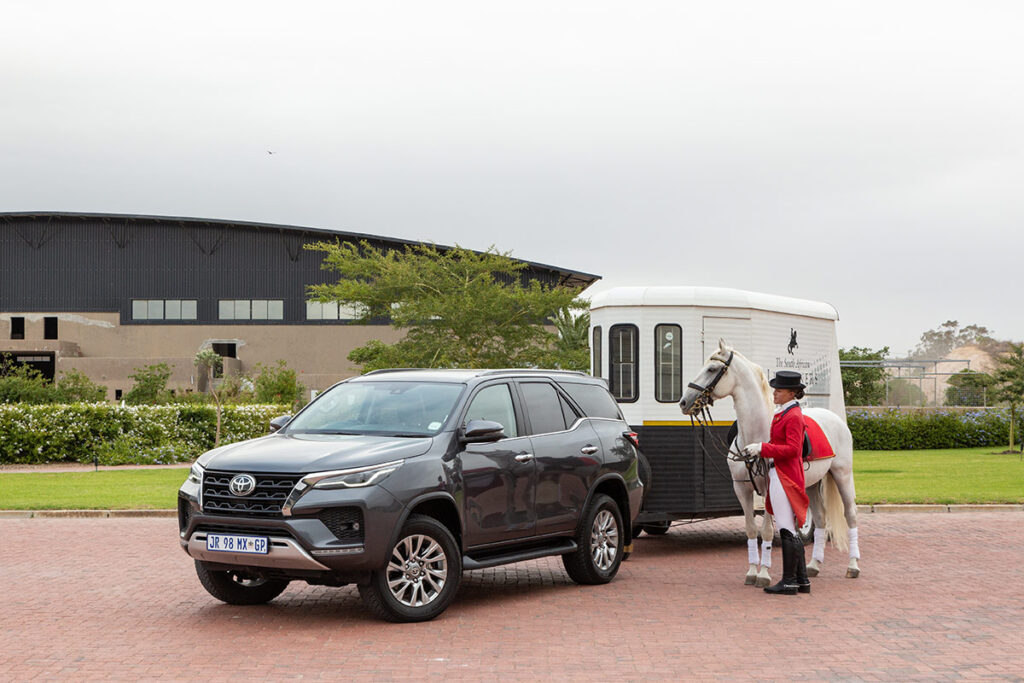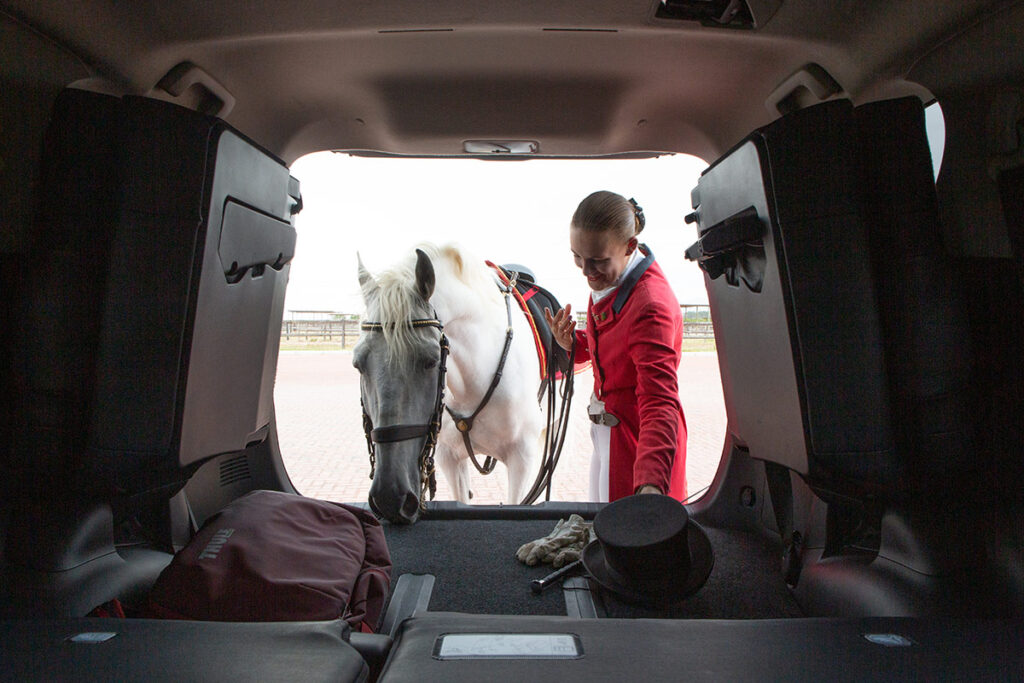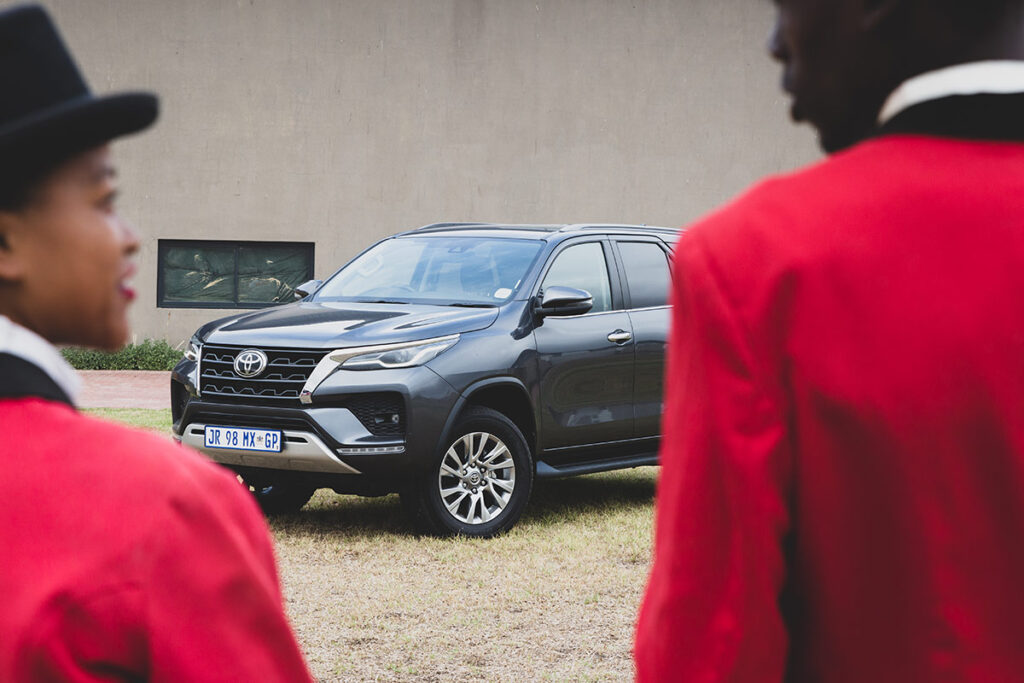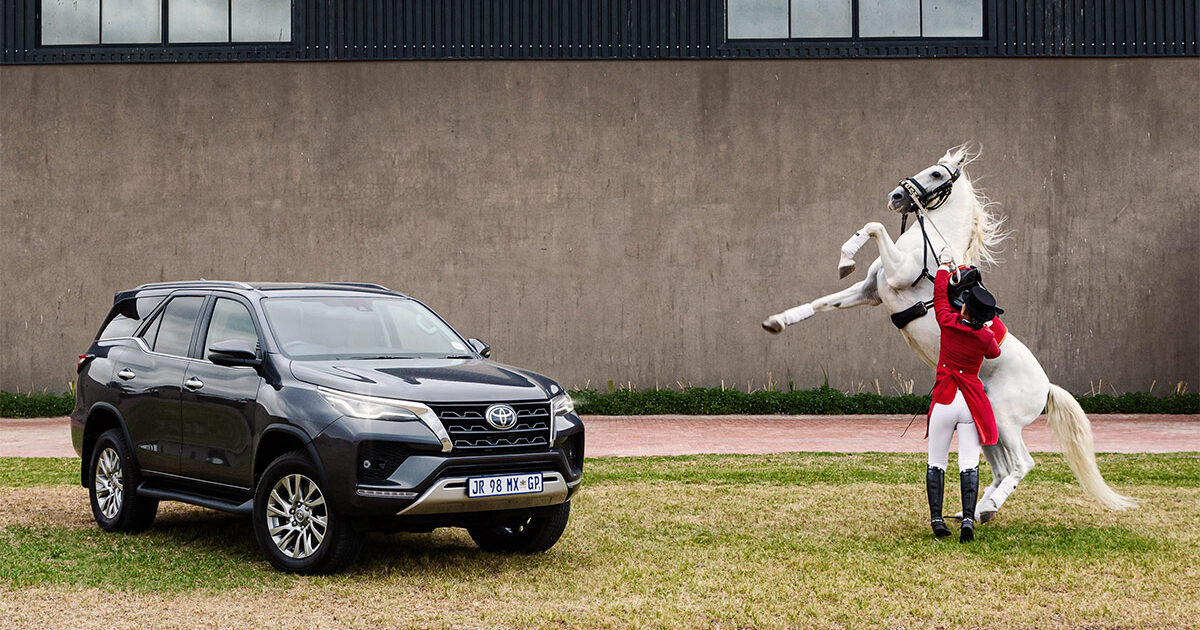In anticipation of the 60th anniversary of Toyota South Africa Motors later this year and the legacy of the horse logo initially used as company emblem, we took the latest Fortuner – now with more horsepower – to meet the South African Lipizzaner horses at their new home near Paarl in the Western Cape.
When Toyota South Africa was established here in 1961, the Japanese manufacturer did not have an internationally recognised logo but Dr Albert Wessels, founder of the local business, believed that the new company should have some form of emblem associated with it.
His passion for horses was well known and this led to the development of a unique identity for Toyota South Africa – a logo with a rearing white stallion encircled in a red background. What led to the decision to use a white horse is not clear but it may just be that the Lipizzaner horses, then already established in South Africa for more than a decade, could have served as inspiration.
The original horse emblem was used until the mid1970s when it was changed due to Toyota Motor Corporation changing the font of their corporate signage. The South African company followed suit, simultaneously replacing the circle with a red square with rounded edges – as it was deemed to be more in keeping with the design trends of the day.
Interestingly, the Stallion – as the logo was referred to – was never used on any Toyota vehicle but appeared on owner’s manuals and service books, company and dealer material, as well as marketing items (even licence disc holders and car floor mats) as a unique identifier of the company itself. However, by 1989 Toyota in Japan commissioned an international logo. The new stylised T emblem first appeared in South Africa in 1992 and the horse logo was discontinued.
However, as a tribute to Dr Wessels, a statue of the Toyota Stallion still prances proudly in front of the company’s head office in Marlboro, Sandton, and another at the Prospecton plant in Durban. This statue has an intriguing history: initially donated to the Sandton Town Council, it was erected in front of the Sandton Civic Centre but after being vandalised a couple of times, it “disappeared” – eventually resurfacing in Durban …

Fortuner power
By 1992 Toyota South Africa Motors was the leading manufacturer in the country, and this year (2021) the company celebrated its 41st year of market leadership. The Fortuner SUV, based on the best-selling Hilux and originally launched in 2006, contributed to this milestone in no small way – with on average about a thousand units per month sold last year.
The second-generation Fortuner was recently upgraded, receiving sharpened styling, enhanced specification levels, and improved performance, and a new VX flagship grade – as already employed by other Toyota SUV ranges – was introduced.
Styling changes on the VX include a larger, blacked-out grille with a gloss wave-like mesh pattern, a silver-accented skid-plate, sleeker BiLED headlamps and prominent chrome accent strips, a thin chrome beltline extending towards the rear, new tail lamp units with integrated light guides, a roof spoiler, and Fortuner-emblazoned centre garnish at the rear.
A welcome change to the interior is the shift back to black trim (with silver contrast stitching) and a new instrument cluster design with metallic-blue dial faces complement the blue interior lighting. A new eightinch infotainment system with Apple CarPlay and Android Auto functionality, plus navigation, is now also part of the package.
However, probably the most important improvement is a boost in horsepower, with the 2.8litre GDsix engine now delivering an extra 20 kW to produce 150 kW of power and an additional 50 Nm of torque, bringing the figure to 500 Nm – thanks to a larger, heavy-duty turbocharger and new, higher pressure common-rail injection system.

Lipizzaner at Mistico
As one of the oldest domesticated horse breeds in the world today, the Lipizzaner has a long and chequered history – worldwide and in South Africa – that saw the breed sometimes survive against all odds. Purpose-bred for battle, the breed was established in 1562 in Lipica, a village in what is now Slovenia, and it was the iconic war-horse of the Middle Ages.
Lipizzaner horses are almost always exclusively grey as adults, despite being born black or dark brown. There are six classical stallion bloodlines and more than 22 mare families in the Lipizzaner breeding registry and the South African Lipizzaner Centre has representatives from all six stallion lines.
How these iconic European horses found their way to South Africa, is a story of unbelievable commitment, bravery, and daring escape. The journey began in Hungary on the breeding farm of Count Jankovic-Besan near the end of World War II. With the invasion of Hungary by the Red Army imminent, the count decided to move his beloved Lipizzaner horses to Germany.
He strapped them to carts and to carriages, and to prevent them from being eaten in war-torn Europe, he painted their white coats with oil and paraffin so that they appeared terrible and inedible. The sorrowful party made it to Bavaria and from there Jankovic-Besan was able to arrange safe passage to Dorset, England. Here they stayed for two years before securing a place aboard a ship headed for South Africa.
(Related to this story and made famous by the Disney movie Miracle of the White Stallions is the rescue of the Lipizzaner horses from Hostau by the United States Army in the spring of 1945, on instructions of General George Patton. “Operation Cowboy”, as the rescue was known, resulted in the recovery of 1 200 horses, including 375 Lipizzaners. The breeding stock returned to Piber in 1952 and the stallions returned to the Spanish Riding School in 1955.)
In late1948 Count Jankovic-Besan and his horses disembarked in Durban Harbour and he started anew in Mooi River, KwaZuluNatal. In 1956, a chance encounter between Count Jankovic-Besan and exPolish cavalry officer Major George Iwanowksi led to the establishment of an equestrian centre and riding academy in Kyalami, Johannesburg.
This became the home of the South African Lipizzaner Centre (a non-profit organisation) for over 60 years and remarkably, the very first Sunday performance by the Lipizzaner horses took place in 1971 – half a century ago. However, the Covid pandemic nearly caused the demise of the organisation and led to the relocation of the horses to the beautiful Mistico Equestrian Centre in Paarl earlier this year …

Airs Above the Ground
We found our way to Mistico on a cool, misty Cape day – unfamiliar conditions for the horses from the Highveld … The upgraded navigation system of the Fortuner led us to the centre along the R312 and during our short trip from Cape Town, the newfound power in the VX was palpable, making it even more desirable as family cruiser.
At Mistico – one of the largest show venues in the country with two indoor arenas that can accommodate up to 950 people (and a third under construction), various grass arenas, 120 livery barns, 240 show stables, and large paddocks – we were met by JhanMari van den Berg, social media and marketing manager of the South African Lipizzaners, and a trainee rider.
With the help of two other student development riders, Kenny Kgoedi and Juandre Strydom, immaculately dressed in their traditional riding gear, the well-groomed horses were readied for our photo shoot. Having been moved from Kyalami only a month before, the horses were nervous and still somewhat unfamiliar with their surroundings.
I asked JhanMari how they have adapted to their new Cape home. “Really well, all things considered,” she responded. “The amenities at Mistico are fantastic and this helped them to settle in but we will see how they adjust to the Cape Winter weather …” I then showed her an image of the Toyota Stallion logo and asked her whether one of the beautiful horses can replicate the stance …
“Of course,” she said, and went on to explain that the horses were still trained in classic dressage movements and manoeuvres such as Capriole, Courbette, Pesade, and Levade purely for their aesthetic value – a main feature of the South African Lipizzaner Centre’s performances.
However, high-level classical dressage manoeuvres known as “airs above the ground”, while appearing deceptively easy, are incredibly demanding of the horse and take years of training to perfect. Well, I think the images by our photographer Ryan Abbott of the stallion Pluto Odaliska performing the Levade under the guidance of JhanMari, speak for themselves …
With a capacity now rated at 3 300 kg (an increase of 300 kg over the outgoing model) the new Fortuner 2.8 GD6 4×4 model is now an ideal vehicle for horse box towing, and JhanMari did let slip that they already use a Fortuner for towing duties …
Hopefully, the recent move to Mistico, perfectly situated close to the Cape Winelands to expectantly attract both local and overseas visitors, will ensure the long-term sustainability of the South African Lipizzaner Centre and these very special horses – much like the power of a horse logo has seen Toyota’s market share climb to 24.4% of local new vehicle sales on the eve of its diamond anniversary …
Text: Ferdi de Vos | Images: Ryan Abbott/Supplied
The South African Lipizzaner Centre
The South African Lipizzaner Centre is a renowned equestrian establishment now located at Mistico near Paarl, dedicated to the preservation of the Lipizzaner horse in South Africa. Training at the centre follows the strict principles and traditions of classical dressage and the haute ècole and public performances exemplify the harmonious connection between a horse and its rider through carefully choreographed routines set to music. For more information on the history and programme of the South African Lipizzaners, visit www.lipizzaners.co.za.
Mistico Equestrian Centre
Address: R312, Paarl, 7630 | Phone: +27 21 300 0751
Email: admin@misticoequestrian.co.za
Website: www.misticoequestrian.co.za


